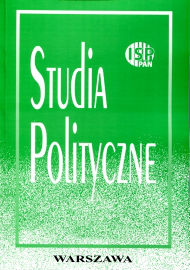Państwo jako ukryta wspólnota, czyli o źródłach konstytucyjnego patriotyzmu. Główne wątki teorii państwa Rudolfa Smenda
The State as a Hidden Community or on the Sources of Constitutional Patriotism. The Principal Threads of Rudolf Smend’s Theory of State
Author(s): Paweł KaczorowskiSubject(s): Philosophy
Published by: Instytut Studiów Politycznych PAN
Summary/Abstract: The article presents an outline of the theory of integration put forth by Rudolf Smend, one of the most renowned of the Weimar theorists of state, whose number also includes Carl Schmitt, Hermann Heller, Erich Kaufmann, Heinrich Triepel... Rudolf Smend’s conception of a state presents a comprehensively understood state order from the point of view of what lies at its base, which is to say, the set of institutions, norms, administrative practices and the social systems they generate and which we, most frequently, identify with the state in the vernacular. According to Smend, this base is provided by a phenomenon of integration which occurs naturally and spontaneously. Integration, which is a concept borrowed from Theodore Litt’s anthropological theory, means a specific type of interpersonal bond which may be described as a space where a specific social communication ensues, a space of understanding. It is a phenomenon which emerges in any human group, including that sui generis, particular and superior group which is a state, where it applies to the most extensive, multimillion population. This integration, in other words, a specific understanding between people, which resembles the Aristotelian notion of friendship and emerges when they are members of a collective constituting one state organism, is precisely what makes up the ‘substance’ of a state, sustaining its existence, stabilising it and rendering it lasting. It is thanks to integration that a state is, in a way, a collective identity. Most frequently, integration ensues unwittingly and spontaneously, but it has its definite forms, based on leadership, procedures and values, respectively. It occurs spontaneously to some degree in every state. However, if it becomes the subject of a deliberate policy, as it did in Bismarck’s Second Reich, it may then be enhanced and optimised. It provides a base for the strength of a state, which is able to survive turning points and crises as a result. Alongside the discovery of the sphere of integration as a deep structure of the state, Rudolf Smend points to a new, previously unknown dimension of human existence, a dimension which enriches the individual living in a state. Rudolf Smend’s concept of a state is, in many respects, the opposite of Carl Schmitt’s. Both authors discuss the issues which they see differently in their extensive correspondence, which has recently been published in Germany.
Journal: Studia Polityczne
- Issue Year: 2014
- Issue No: 35
- Page Range: 33-55
- Page Count: 23
- Language: Polish

